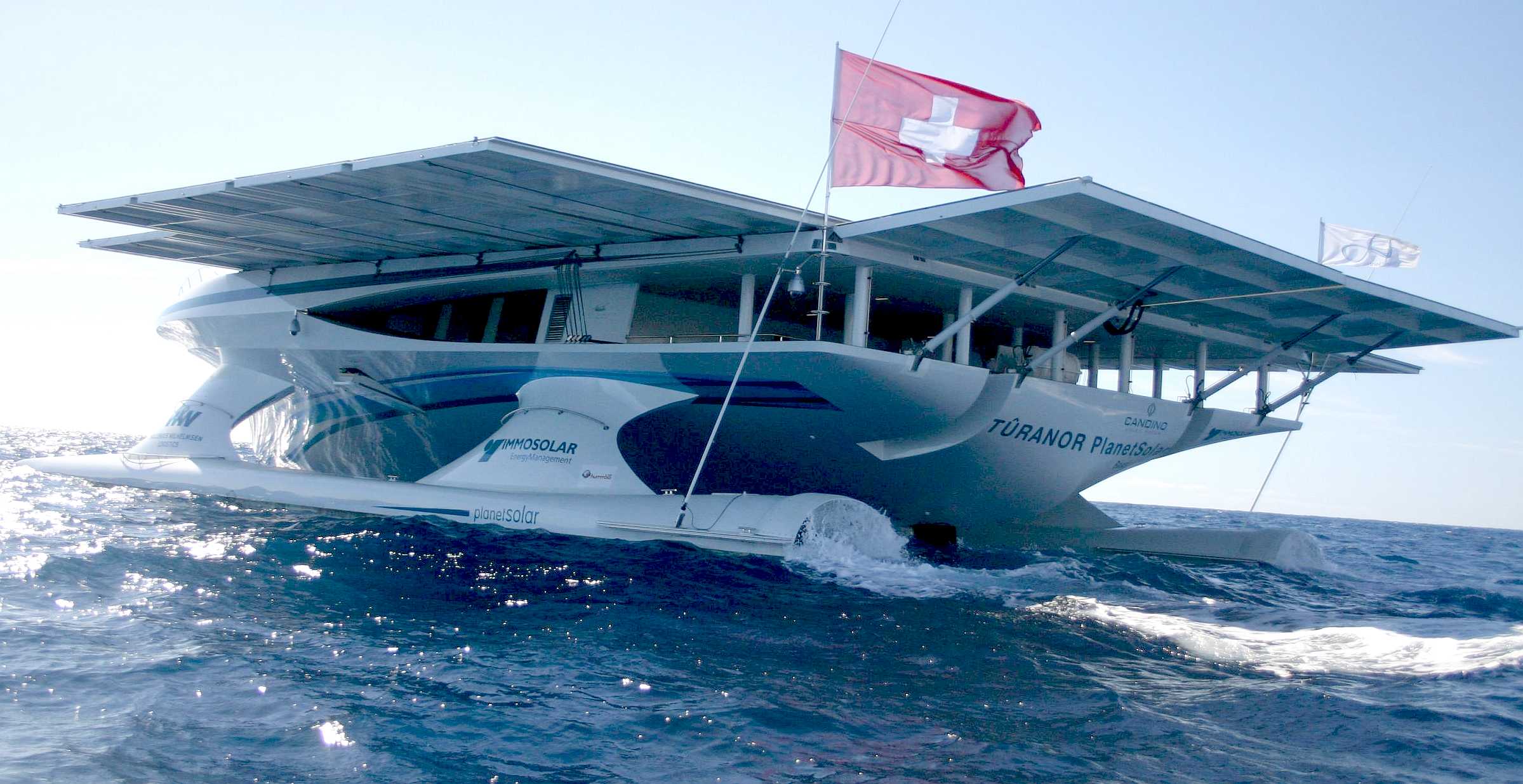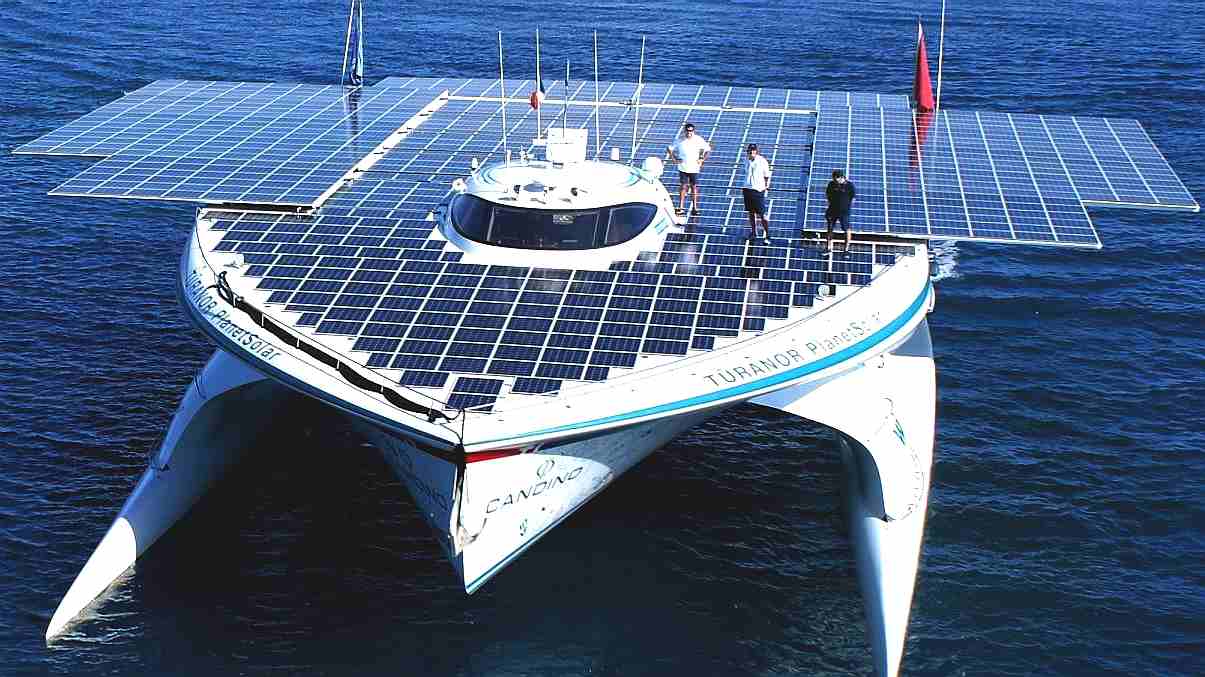
PlanetSolar
is a rare animal, a zero carbon boat that contributes to zero emission
objectives, but attracts no carbon credits. Similar projects with higher
commercial expectations in reducing fleet emissions, also fall at the
first hurdle in UN certificate terms. But projects to plant trees or
change from coal to solar or wind generation pass with flying colours.
WHAT IS THE KYOTO PROTOCOL ?
The Kyoto Protocol was adopted on 11 December 1997. Owing to a complex ratification process, it entered into force on 16 February 2005. Currently, there are 192 Parties to the Kyoto Protocol.
In short, the Kyoto Protocol operationalizes the United Nations Framework Convention on Climate Change by committing industrialized countries and economies in transition to limit and reduce
greenhouse gases
(GHG) emissions in accordance with agreed individual targets. The Convention itself only asks those countries to adopt policies and measures on mitigation and to report periodically.
The Kyoto Protocol is based on the principles and provisions of the Convention and follows its annex-based structure. It only binds developed countries, and places a heavier burden on them under the principle of “common but differentiated responsibility and respective capabilities”, because it recognizes that they are largely responsible for the current high levels of GHG emissions in the atmosphere.
In its Annex B, the Kyoto Protocol sets binding emission reduction targets for 37 industrialized countries and economies in transition and the European Union. Overall, these targets add up to an average 5 per cent emission reduction compared to 1990 levels over the five year period 2008–2012 (the first commitment period).
In Doha, Qatar, on 8 December 2012, the Doha Amendment to the Kyoto Protocol was adopted for a second commitment period, starting in 2013 and lasting until 2020. However, the Doha Amendment has not yet entered into force; a total of 144 instruments of acceptance are required for entry into force of the amendment.
The amendment includes:
- New commitments for Annex I Parties to the Kyoto Protocol who agreed to take on commitments in a second commitment period from 1 January 2013 to 31 December 2020;
- A revised list of GHG to be reported on by Parties in the second commitment period; and
- Amendments to several articles of the Kyoto Protocol which specifically referenced issues pertaining to the first commitment period and which needed to be updated for the second commitment period.
On 21 December 2012, the amendment was circulated by the Secretary-General of the United Nations, acting in his capacity as Depositary, to all Parties to the Kyoto Protocol in accordance with Articles 20 and 21 of the Protocol.
During the first commitment period, 37 industrialized countries and economies in transition and the European Community committed to reduce GHG emissions to an average of five percent against 1990 levels. During the second commitment period, Parties committed to reduce GHG emissions by at least 18 percent below 1990 levels in the eight-year period from 2013 to 2020; however, the composition of Parties in the second commitment period is different from the first.
THE
THREE MECHANISMS
The
Protocol provides for three mechanisms that enable countries or operators in developed countries to acquire greenhouse gas reduction credits.
1. Under Joint Implementation (JI) a developed country with relatively high costs of domestic greenhouse reduction would set up a project in another developed country.
2. Under the Clean Development Mechanism (CDM) a developed country can 'sponsor' a
greenhouse gas reduction project in a developing country where the cost of greenhouse gas reduction project activities is usually much lower, but the atmospheric effect is globally equivalent. The developed country would be given credits for meeting its emission reduction targets, while the developing country would receive the capital investment and clean technology or beneficial change in land use.
3. Under International Emissions Trading (IET) countries can trade in the international carbon credit market to cover their shortfall in Assigned amount units. Countries with surplus units can sell them to countries that are exceeding their emission targets under
Annex B of the
Kyoto
Protocol.
These carbon
projects can be created by a national Government or by an operator within the country. In reality, most of the transactions are not performed by national
Governments directly, but by operators who have been set quotas by their country.
To
date the Elizabeth
Swann project has not been set a quota by any country. We do though
consider that there should be such potential, and not just for this
project, but for any high-tech solution to climate
change, with reasonable prospects of success.
THE
UNFCCC SECRETARIAT
The UNFCCC secretariat (UN Climate Change) is the United Nations entity tasked with supporting the global response to the threat of climate change. UNFCCC stands for United Nations Framework Convention on Climate Change. The Convention has near universal membership (197 Parties) and is the parent treaty of the 2015 Paris Agreement.
The main aim of the Paris Agreement is to keep the global average temperature rise this century as close as possible to 1.5 degrees Celsius above pre-industrial levels. The UNFCCC is also the parent treaty of the 1997 Kyoto Protocol. The ultimate objective of all three agreements under the UNFCCC is to stabilize greenhouse gas concentrations in the atmosphere at a level that will prevent dangerous human interference with the climate system, in a time frame which allows ecosystems to adapt naturally and enables sustainable development.
...
ANNEX
B
ARTICLE 12
CARBON
TRADING OFFSETS
COMPLIANCE
CARBON OFFSETTING
GOLD
STANDARD
IMO
MARINE ENVIRONMENT PROTECTION
KYOTO
PROTOCOL
MARKET
PRICE INDEX
PARIS
AGREEMENT
VOLUNTARY
VERIFIED STANDARD
LINKS
& REFERENCE
https://unfccc.int/kyoto_protocol
https://unfccc.int/climate-action/climate-neutral-now
https://ec.europa.eu/clima/policies/ets/registry_en


